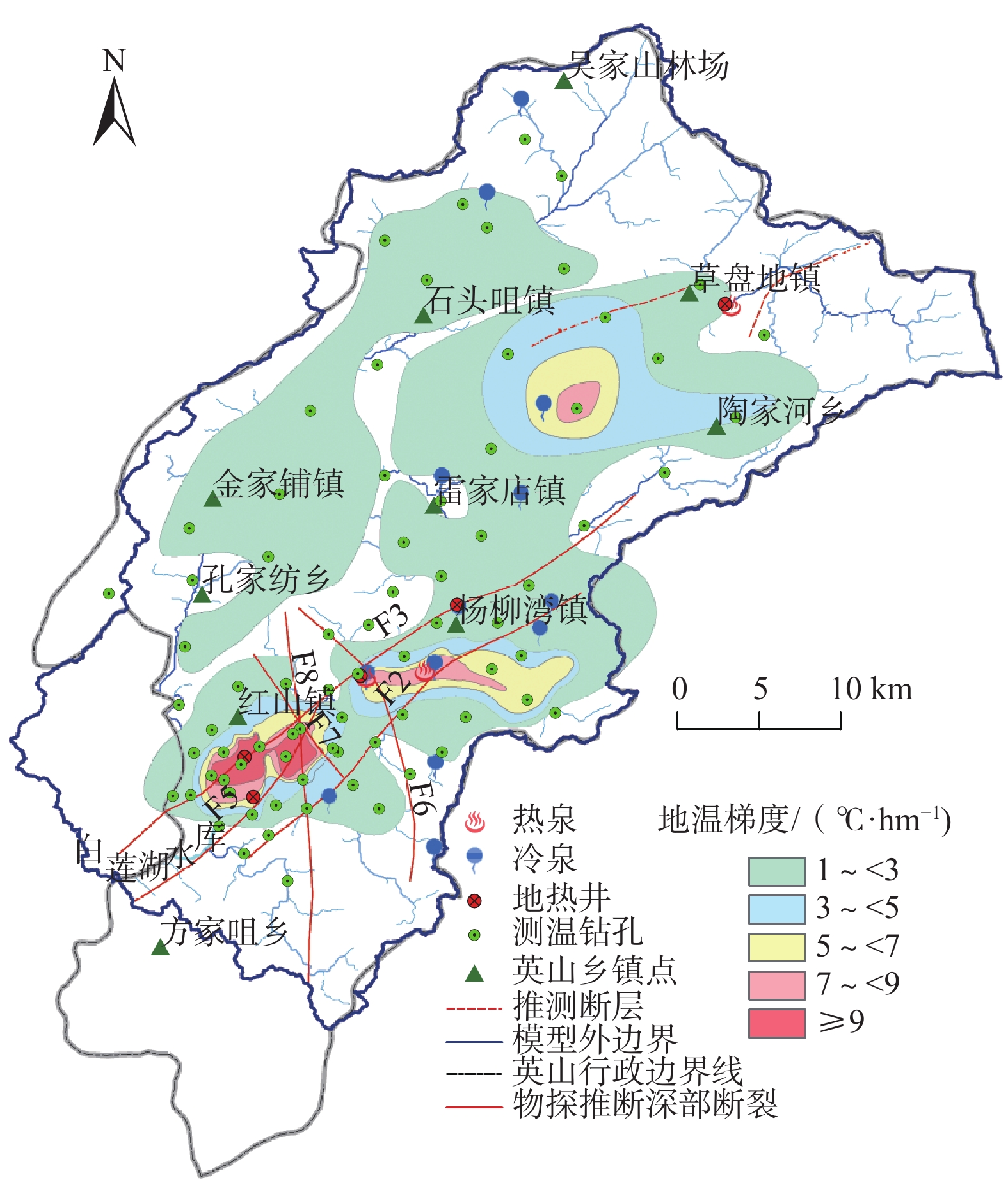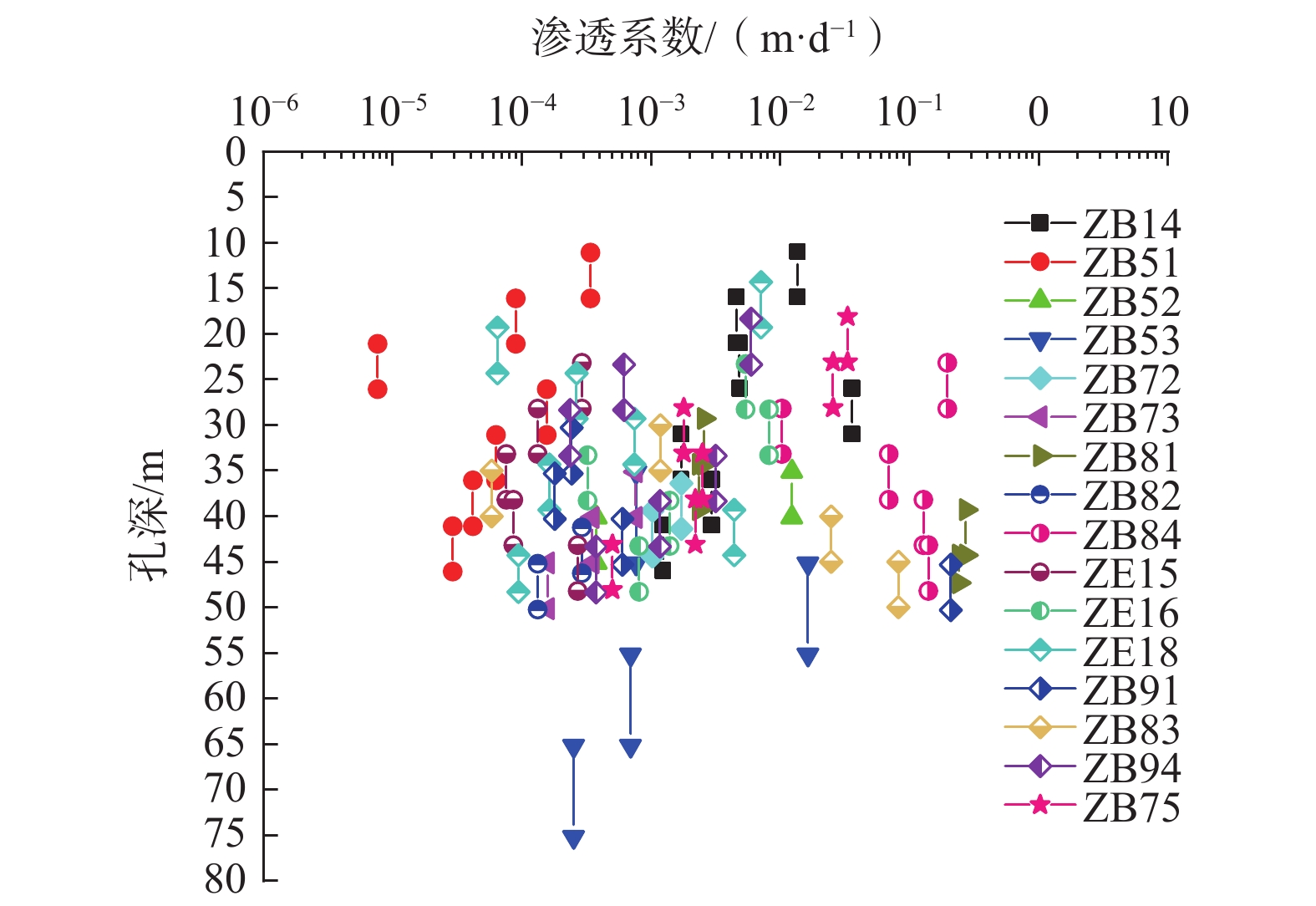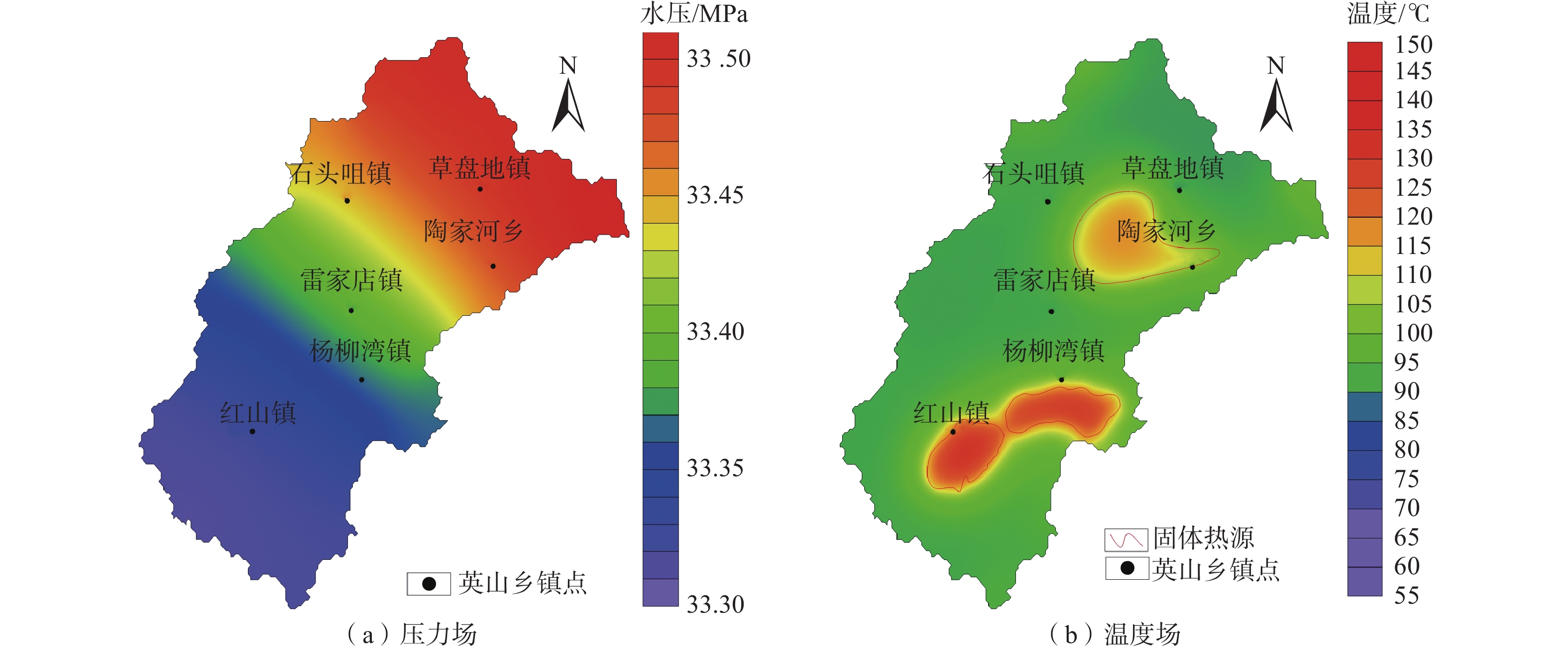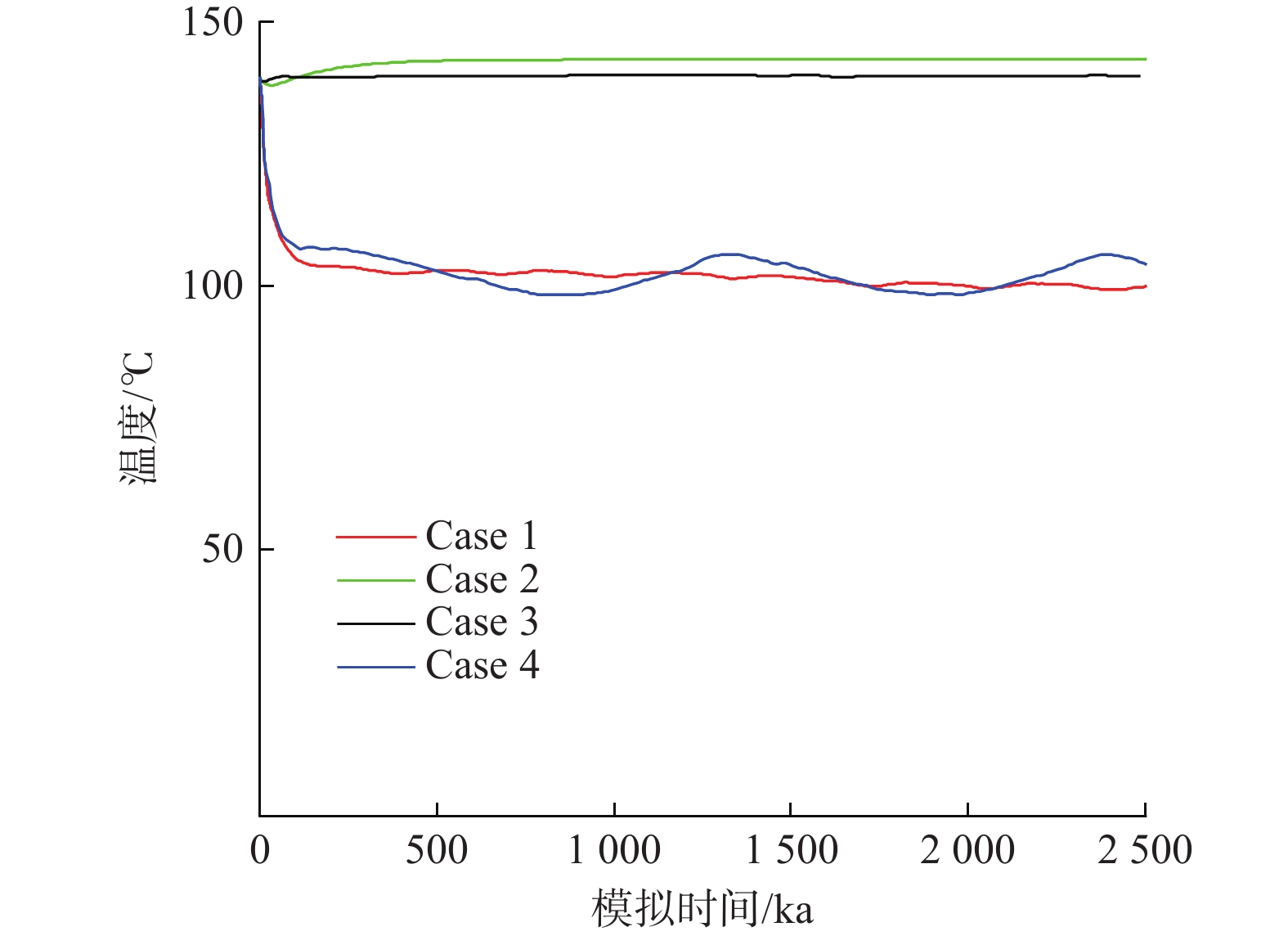The impacts of deep faults on fluid migration, heat accumulation with implication to genesis of Yingshan geothermal system
-
摘要:
目前对英山地区深部地温场的分布情况以及构造控热模式尚无系统研究,不利于地热资源科学的开发利用。基于野外裂隙测量、浅层连续测温、钻孔压水试验等成果,建立了英山裂隙岩体地下水渗流-传热三维模型,对深部储层在不同构造组合模式下的压力场、温度场和达西流速场进行分析。研究结果表明:研究区深部温度场和压力场受断裂系统影响较大,在致密基岩及隔水断层处,流体运动微弱,热量运移以热传导为主,导水断层处以热对流为主;在深部导水断层区域温度和水压偏低,与导水断层处相比,隔水断层处水压偏高;在2000 m深度以深,高温区和水力交换强烈区与导水断层带处完全对应,表明断层是储层中最主要的流体和热量运移通道;区内断层组合模式为复合模式,北东向断层为英山地区主要导水导热构造,热水在沿北东向断层向上运移的过程中,受南北向断层的阻隔,最终在两组断层的交叉复合位置处形成温泉。该研究可为研究区内的地热资源科学勘查和合理开发利用提供参考。
Abstract:The distribution of the deep geothermal field and the tectonic thermal control mode in the Yingshan area were not understood systematically, which would bring in constraints to the sustainable exploration of local geothermal resources. Based on the field survey on continuous temperature, fracture measurements in the outcrops of granite rock, slug-test, and pumping test in the boreholes, a three-dimensional model coupling fluid flow and heat transfer process in fractured rock reservoir was established. Then the distribution of fluid pressure temperature and the Darcy velocity in the whole geothermal reservoir were calculated considering different treatment combinations of main faults. The results show that the deep temperature field and fluid pressure distribution are greatly affected by the faults system. At the location of bedrock and impermeable fault, the fluid movement is very weak, and the heat transfer is mainly controlled by heat conduction, while in the high permeable fault, it is mainly controlled by heat convection. Low temperature and fluid pressure occurred in the deep, high-permeable fault zone whereas high fluid pressure occurred in the impermeable fault zone. At a depth larger than 2000 m, the zones with high temperatures and intense hydraulic exchange coincide with the conductive fault zones, which indicates that the high-permeable faults are the most important channel for seepage and heat transfer in the reservoir. Therefore, the northeast faults are the dominant channel for fluid migration and heat conduction in the Yinshan area. Hot water migrates upward along the northeast faults and is blocked by the north-south fault. The hot spring is formed at the intersecting position of two groups of faults. This study is helpful for scientific, sustainable exploration of geothermal resources in the Yingshan area.
-
地热能是一种极具竞争力的清洁可再生能源[1],具有较高开发利用价值。我国地热资源丰富且分布广泛,根据热的赋存方式,可以分为干热型和水热型[2 − 3]。目前地热开发一直以赋存在高渗透型的孔隙或裂隙介质中的水热型地热资源为主体[4 − 8]。构造地质环境是地热田发育的先决条件,从构造环境角度可以将地热系统分为沉积盆地型和隆起山地型[9 − 13]。
近年来对水热型地热系统成因模式的研究主要集中在地质构造背景调查[14 − 15]、地热水化学[16 − 18]及同位素特征分析[19]等方面,或综合上述手段提出地热成因概念模型。数值模拟因其在验证地热成因模式的正确性方面具有显著优势而受到了广泛应用[20 − 21]。断层通常是地热流体运移与热量传输的良好通道,准确模拟断层对流体运动和传热的影响是地热成因数值模拟的主要难点之一。目前,在储层尺度上对构造的控水控热规律进行系统研究的较少。Przybycin等[22]构建了盆地尺度的热流耦合模型,通过数值模拟,验证了断层的存在对区域温度场分布有控制作用;Pola等[23]针对某低温地热系统,建立了考虑区域导水断层的热流耦合模型,认为区域导水断层带是热水通道,有利于热对流,从而加速热水上涌。
然而,多数研究简化了对断层性质的刻画,多是将不同方向断层交叉部位简单地视为地下热水富集、出露的有利空间[24 − 26],或是在模型中将断层带统一刻画为高渗透带[27 − 29]。前人研究大多侧重刻画断层的水力性质,忽略了其传热导热性,特别是未能考虑实际断层带几何展布特征的多样性及其对地热系统的控水控热组合作用。López等[30]模拟考虑了各向异性渗透性的断层带,引入了复杂的循环模式,提出断层分布的方向性会显著影响传热及对流的效率,相比于沿倾斜方向,顺断层方向的对流效率更高。Mcnaamara等[31]首次利用声学钻孔电视仪记录的数据对新西兰地热田地下结构应力场进行分析,得出断裂倾角方向上存在复杂异质性的结论。
湖北英山地热田位于鄂东大别造山带,通过物探、大地构造历史等成果确定区内构造样式主要受区域性构造罗田穹隆和郯庐断裂演化过程影响。该地热田地质条件复杂,研究程度较低,对深部地温场的分布情况以及构造控热模式尚无系统研究,制约了地热资源的开发利用[32]。本次研究围绕英山地热田开展了地热田地质调查、物探、钻探、钻孔测温、压水试验和岩矿分析等工作,综合野外调查和室内试验成果,建立了三维地下水流动和传热的多场耦合模型,考虑到断层复杂组合特性,通过数值模拟,探讨区域断层对地热流体运移和地温分布的影响,阐明英山地热系统的形成机制,为该区地热资源勘察和开发利用提供重要的技术支撑。
1. 研究区背景
英山地处中央造山带大别山腹地,地形以中低山丘陵为主,海拔为97.9~1729.1 m,总体北东高西南低,主要有东河和西河2个水系,见图1(a)。多年平均温度为16.85 °C,年降雨量在962.5~2563.5 mm之间。该区域位于华北板块和扬子板块之间[33]。在中生代由于大陆俯冲碰撞造山作用,构造活动强烈,形成了很多深大断裂,以北西向(F7)、北东向(F2、F3、F5)及近南北向断层(F6、F8)为主,地质条件复杂。断裂构造控制地热水的形成,区内热泉和地热井分布见图1(a)。区内岩浆岩发育,主要由大别—吕梁期超基性、基性及中、酸性岩和燕山期酸性花岗岩组成,除太古界大别—吕梁期的花岗岩体外,还有中生代花岗岩类出露,见图1(c)。区内地下水类型主要包括第四系松散孔隙水和基岩裂隙水。区内地下水主要补给来源为大气降水,补给区为北部天堂寨等地的中-低山区,海拔约为1635 m,径流区位于天堂寨山区与英山地热场之间的断层破碎带和裂隙带,热水以温泉形式排泄于断层交汇带处。
2. 模型建立与计算
2.1 概念模型
研究区包括东河和西河在内的整个英山地区水系流域,总面积约为1395 km2。英山地热系统含水层结构概化为:松散孔隙潜水含水层(顶底板高程范围为−300~1535 m),水位埋深随季节变化,一般在2~4 m,岩性主要为中细砂、砂砾石层,热储集层;变质岩裂隙含水层(高程范围为−1500~−300 m),构造裂隙发育,为主要热储集层;花岗岩裂隙含水层(高程范围−3000~−1500 m),为干热岩目标层;此外,地表河流两侧漫滩分布的全新统黏土和全风化的地表岩石概化为热储盖层。
水流模型大部分边界为地表分水岭,处理为隔水边界;西南部以白莲湖水库为界,水库水位稳定,处理为定水头边界;将东河、西河处理为通用一类边界。表层第四系地层作为盖层,具有保温性能,处理为定温度边界,按照英山地区常年平均地表温度16.3 °C赋值;模型侧面作为隔热边界。据已有研究,英山地热田热源包括2部分,来自地幔热流释放的热量和酸性岩浆岩放射性生热或岩浆余热[34],因此,将模型底边界设为恒定热流边界,参考研究区邻区罗田当地大热流平均值,底边界热流值取为67 mW/m2。本次还开展了表层氡汞地球化学调查[34],通过土壤汞浓度异常区判断深处存在高放射性岩体,为释汞过程提供优势通道,进一步确定地热田热储上升通道,辅助圈定地热田范围。通过岩土体中氡元素异常高值确定断裂构造位置和隐伏断层,推测地热流体富集部位。在此基础上,结合区域内浅层测温结果圈定的地热异常范围(图2)初步设定放射性固体热源形状。通过研究区开展的经验地热温度计和混合计算模型确定热储深度在−3000~−2000 m范围,热储取值范围为5~9 J/(m3·d)。
此外,综合大地电磁法研究结果和前人对本地区构造行迹成因的认识[24, 35],推断研究区内深部大断裂带由2组断裂构成:北东向断裂主要为张性、张扭性断裂,近南北向断裂主要为压性、压扭型断裂,见图1(a)。对以上深大断裂的位置、主方向和性质等在模型中进行了重点模拟和分析。
2.2 数学模型
研究区数学模型包括2部分:(1)地下水水流模型,可概括考虑断裂带特性的非均质各向异性三维饱和非稳定流;(2)温度场模型,用来描述地热系统温度场中热量运移。根据流体质量守恒定律、动量守恒定律以及热能守恒定律可以推导出描述流体在介质中流动和热传输的基本方程。
考虑地下水运动服从达西定律,但在FEFLOW软件中求解的是当量水头:h=pρg+z,因此,推导后的动量方程为:
qi=−ρgkiju(∇h+(ρ−ρ0)ρ0⋅∇z) (1) 式中:q——流体速度;
ρ——流体密度;
g——重力加速度;
z——位置水头;
{k}_{ij}—— 渗透率张量;
u——动力黏度;
{\nabla }{h} ——水头的梯度,表示水头具各向异性;
{\rho }_{0} ——参考密度。
基于Boussinesq近似的质量守恒方程,假定流体是唯一的可压缩项,在等温条件下,水头方程为:
\phi \rho g\beta \frac{\partial h}{\partial t}+\nabla \cdot \left(\rho q\right)=0 (2) 式中: \phi ——介质孔隙率;
\beta ——流体的压缩性;
h——水头;
t——时间。
假定流体和固相之间存在热平衡,忽略流体密度和孔隙率的变化,热能守恒得到传热方程:
{\left(\rho c\right)}_{\mathrm{b}}\frac{\partial T}{\partial t}-\nabla \cdot \left({\lambda }_{\mathrm{b}}\nabla T-\rho {c}_{\mathrm{f}}qT\right)-H=0 (3) {\left(\rho c\right)}_{\mathrm{b}}=\phi {\rho }_{\mathrm{f}}{c}_{\mathrm{f}}+\left(1-\phi \right){\rho }_{\mathrm{s}}{c}_{\mathrm{s}} (4) {\lambda }_{\mathrm{b}}=\phi {\lambda }_{\mathrm{f}}+(1-\phi {)\lambda }_{\mathrm{s}} (5) 式中: {\left(\rho c\right)}_{\mathrm{b}}——介质的体积热容;
{\lambda }_{\mathrm{b}}——介质的热导率;
c——介质的比热容;
T——温度;
H——考虑放射性生热的热源项;
f、s——液相、固相。
由于实际问题各个变量的不同,式(2)(3)最终将通过设置流体密度和黏度的形式实现耦合。对于本次研究的实际问题,流体黏度保持不变,而流体密度随温度线性变化,遵循公式 \rho ={\rho }_{0}(1-\alpha \Delta T) ,α为流体的体积热膨胀系数。
2.3 数值建模
2.3.1 三维地质结构模型
借助FEFLOW软件实现三维地质结构离散,垂向剖分16层,其中对断层、地热井等处进行局部加密,最终得到三维节点268073个,单元网格478512个。本次模拟的断裂带深度范围为地表到地下2800 m深度。考虑到断层的几何展布和特殊性质,在模型中,首先在空间离散时对断层及其附近进行网格加密处理,6条主体断层采用“Discrete Features”模块,调用Darcy流动法则进行刻画,并将深大断裂带周围的破碎影响带进一步细分,刻画为14677个棱柱形网格单元,叠加到模拟区域,见图3。通过赋值离散单元连接面(join-face)的渗透系数刻画深大断裂本身的导水、阻水、导热等特性。断层导水性越好,则该断层附近离散单元连接面的渗透系数取值越大。通过赋值断层破碎影响带的水文地质参数刻画深大断裂对周围基岩的影响。
2.3.2 模型参数
岩石渗透性参数和储层热物性参数,是渗流-传热耦合模型中重要的参数[21, 36]。本次研究开展了地表露头岩石节理裂隙测量、钻孔浅层测温与压水试验等工作,采集17件露头岩样和11件岩芯样进行压汞实验和热物性参数测试,具体位置见图1(a)。统计东河、西河裂隙倾角,结果表明区内优势裂隙方向为北东向(图1a)。分析16个钻孔73段的现场分段压水试验数据,计算得到(压水试验点位见图1a):岩石吕荣值在0.01~10之间,渗透系数为10−4~10−2 m/d,属于极微透水至弱透水型;渗透系数整体随钻孔深度增加而降低(图4)。压汞试验结果表明:岩样孔隙以微孔为主,孔隙度为0.20%~0.83%,渗透率在0.054~1.618 mD之间。此外,采用平板法(误差为4%)>测试岩土热导率、比热容和热扩散系数等热物性参数。研究区热导率在1.793~2.785 W/(m·K)之间,平均值为2.358 W/(m·K);比热容在1.594×106~1.994×106 J/(m3·K)之间,平均值为1.847×106 J/(m3·K);热扩散系数在0.965×10−6~1.461×10−6 m2/s之间,平均值为1.282×10−6 m2/s。
在模型中根据不同岩性分布特征,参考实测值对岩石热物性参数(导热系数、比热容)和水力特性参数(渗透系数、孔隙度)进行分区赋值,其中基岩热导率赋值为3 W/(m·K),比热容赋值为2×106 J/(m3·K),模型内各类岩石及断层破碎带的水文地质参数赋值见表1。
表 1 模型各类岩石及断层破碎带的水文地质参数赋值范围Table 1. Hydrogeological parameters assigned to the different rock mass and fault zones in the model热储分类 渗透系数/(m·d−1) 孔隙度 有效传热孔隙率 Kxx Kyy Kzz 松散沉积物 5.19×10−2 5.19×10−2 5.19×10−3 0.19 0.14 花岗岩基岩 7.64×10−7~7.64×10−3 7.64×10−7~7.64×10−3 7.64×10−9~7.64×10−5 0.02~0.04 0.10~0.14 导水断层破碎带 0.010~0.273 0.010~0.273 0.01~27.30 0.05~0.29 0.2~0.4 隔水断层破碎带 7.64×10−10~7.64×10−6 7.64×10−10~7.64×10−6 7.64×10−12~7.64×10−8 0.05~0.29 0.2~0.4 研究区存在北北东向和南北向2个近正交的主断层带,断层带具有导水或阻水作用。考虑到一般情况下导水断层处水力连通性好,通常伴随着较好的导热性,即表现为导水导热的特征;而隔水断层处渗透性差,且周围花岗岩自身导热性一般,因此整体表现为隔水阻热的特征。为了精确刻画各个深大断裂的导水、阻水、导热等组合特性,对不同方向的断裂带分组,形成Case 1—Case 4四种组合,由此实现对区内深大断裂控制作用的研究(表2)。
表 2 4种断裂带分组组合情况下Fracture离散单元参数设置Table 2. Parameters of the discrete fracture unit under 4 Cases of fault group模型 断裂带分组/属性设置 渗透系数/(m·d−1) 有效传热孔隙率 导热系数/(W·m−1·K−1) 比热容/(106 J·m−3·K−1) Case1 全部断层/导水导热 86.4~432.0 1 5 2 Case2 全部断层/隔水阻热 7.64×10−12~7.64×10−8 0.0001 0.278 0.02 Case3 北东向(F2、F3、F5)/隔水阻热 7.64×10−12~7.64×10−8 0.0001 0.278 0.02 南北向(F6、F7、F8)/导水导热 86.4~432 1 5 2 Case4 北东向(F2、F3、F5)/导水导热 86.4~432 1 5 2 南北向(F6、F7、F8)/隔水阻热 7.64×10−12~7.64×10−8 0.0001 0.278 0.02 由于深部断裂实测资料少,隔水断层参数设置时在岩样实测最小值的基础上减小2个数量级;导水断层参数取实测最大值;断层宽度综合野外调查和文献[23]数据取50 m。需要指出的是,在断层带刻画中,断层破碎带的物性参数会随着断层离散单元的性质同步修改。表1和表2中参数赋值范围均考虑了岩石孔渗特性随深度减小这一规律,渗透系数、孔隙度和有效传热孔隙率[23]均随深度递减。
3. 数值模拟结果分析
3.1 稳定流模拟与模型验证
在不考虑断层及破碎带的影响下,将英山县多年平均降雨量计算的降雨入渗补给量代入三维水热耦合模型,模型各项参数取值见表1,通过稳定流模拟运算得到研究区地下水压力场和温度场的三维空间分布。图5显示了深部3000 m处的流体压力场和温度场。深层地下水整体由北向南运动,与实际地下水运动方向一致。同时,通过不断调参进行稳定流模拟计算与表层氡汞地球化学调查[34]和浅层测温的结果(图2)互相验证,最终确定研究区深部固体热源的位置及大小,见图5(b)。此外,研究区开展的经验地热温度计(二氧化硅温度计、阳离子温度计)和混合计算模型(硅-焓混合模型、多矿物平衡模拟)的研究结果表明温泉镇地热系统(与红山镇相邻)深部热储温度为120~142 °C,杨柳湾地热田深部温度为115~164 °C,草盘地地热系统深部热储温度为164~179 °C(循环深度在4700 m以深)[34]。这与稳定流模拟得出的温度场中高温异常区范围和热源温度值完全对应,说明建立的三维数学模型中相关物性参数设置合理,渗流-传热耦合过程成立,所建模型可以用于渗流-传热耦合模拟计算。
3.2 区域断裂的影响
3.2.1 断层附近温度随时间的变化
为深入探究断层对深部流体运移与热量传输的影响,在稳定流模拟计算结果的基础上加入4种断层组合模式(表2),开展非稳定流模拟,计算整个模拟区流体压力场和温度场的时空分布。考虑到各种影响因素(如区域和局部断层、放射性生热等)对温度分布的作用,并借鉴已有模型经验[23],将模型的总模拟时间设置为2500 ka,时间步长均为10000 a,以确保模拟结果达到准稳态。为方便对比,将北东向断层(F3)附近的浅层测温点处深度为2800 m的位置作为控制点(图3b)。图6显示了4种断层组合模式下控制点处的温度随时间的演化规律。由图可知,4种模型均在500 ka内达到稳态,但最终达到收敛的温度值和波动趋势存在差异。其中Case2与Case3的波动趋势较为一致,都比较平缓,而Case2全隔水的情况下温度最高;Case1与Case4温度变化趋势一致,且Case4的温度波动幅度更为显著。考虑到控制点处,在Case2与Case3中,F3断层被刻画为隔水断层;而Case1与Case4则正好相反,表明断层带周围温度场的变化受到断层性质的影响,且不同组合模式带来的影响差异显著。在Case1与Case4中,F3北东向导水断层与初始地下水流场方向一致,分析造成这种组合模式差异的原因正是受到初始地下水流场的影响。
3.2.2 区域断裂对平面上热场和流场的影响
4种情况下2800 m深度处平面上压力场与温度场分布情况见图7。由图可知,相较于隔水断层处,导水断层所在的位置都出现温度和水压比较低的情况。推测产生这一现象的原因是:在含构造裂隙的花岗岩储层中,地下水流总是趋向于沿着导水断层下渗或上涌,形成平面上的低压区,而在垂向上隔水断层处水压相对较高。在导水断层处,热对流作用加强,地表冷水沿导水断层下渗,带入较冷的温度,伴随被热源加热的热水从断层处上涌与冷水混合后导致热量流失;在隔水断层处,由于不存在热对流,在热传导的作用下热源对应位置的上方温度相对较高。因此,在同一深度,导水断层处的水温相较于其他位置略低一些。
3.2.3 区域断裂对垂向上热场和流场的影响
由于深部温度场的变化与地下水流速紧密相关,流速值的变换通常指示热量运移方式的改变,流速快的地方指示热对流,流速微弱的地方代表热量运移以热传导为主。因此,截取三维模型中沿剖面线地表至地下3000 m的平面,得到4种断层组合处理模式下的达西流速场、温度场和流体压力场分布,如图8—10所示(A—B、C—D剖面位置见图3b),可用于分析基岩和断层处地热流体的垂向运移特征。
由图8可知,深部整体流速的绝对值为5×10−7~0.013 m/d、地下水流动缓慢,整体符合达西流运动特征。基岩和隔水断层处流体运动非常微弱,热量运移以热传导为主,流体流动以平流为主,阻挡了浅部冷水下渗到深部岩层,由此说明浅层冷水和深层热水的混合只可能在导水断层处发生。导水断层在低渗花岗岩基岩中充当了优势通道,断层带中流速在平面和垂向上都明显高于基岩中的流速,指示从基岩到导水断层处,热量运移方式由热传导转为热对流。
在垂向上,温度场表现出与流速场一致的规律,见图9。温度暖锋沿导水断层向上推进,而基岩和隔水断层处体现热传导模式下的温度层层递进的稳定变化。在深部同一热源位置处(图7、图9),由于导水断层处热量的流失,水温相对于其他位置略低。然而,这种现象从地表到深部并不完全一致,从图9可以看出,深部2000 m至地表,沿导水断层向上推进的暖锋处温度是最高的,浅层地表热异常区域与导水断层展布方向一致。这表明在长时间尺度下,热对流相比热传导模式加热的更快。同时,由于热对流模式依靠水的对流不断吸取深部热源的热量,从而使得地下水增温形成地热流体,而热传导模式主要依靠深部热源和岩石的导热性能传递热量,热量传递速度相对缓慢,向上加热的范围有限,因此,热对流能将更多的热量更快地从深部带上地表。在Case2模式下,2个方向的断层均设置为隔水性质。由图9可知,虽然模拟区深部温度较高,但缺乏热量向上传输的快速通道,即导水断层,核心区浅层温度依然较低。所以推测本区域内至少存在1条导水断层,在浅层才出现地热流体。温泉的产生除了需要有深部热源和作为通道的导水断层外,还需要满足静水压力条件。
对比垂向剖面上0~3000 m的水压变化,见图10。在深部,隔水断层处等压线呈向上凸的趋势,而导水断层处出现泄压趋势,这反映隔水断层处会积聚较高的压力,这与前期深部平面压力场分析得出的规律一致。一般情况下,地下水流动总是趋向于从高压区向低压区流动,因此,隔水断层的存在有助于推动热水上升到地表形成温泉。所以推断本研究区的构造模式应该是2种不同性质断层的复合模式。
观察2种不同性质断层交叉附近,Case3和Case4模式下在导阻水断层交叉的位置处都形成了一个明显的优势流通道(图8),热量和水流可以在通道内快速运移。在温度场同一位置处Case3体现相应的冷水下渗界面,而Case4中同时出现冷水下渗界面和向上推进的暖锋面(图9),这表明深部加热后的流体可沿导、阻水断层交叉处上升至地表,形成温泉。
4. 成因模式讨论
通过以上分析,推断英山地区地热形成过程中断层的作用与Case4模式最为接近。在Case4模式中,北东向断层作为导水导热断层,浅层温度热异常区域沿北东向导水断层分布(图9),而实际地热温泉出露点也大多分布在北东向断层附近(图1a)。此外,从图8中 Case4 C—D剖面中可以看出:在南北向断层与北东向断层交叉处,形成了3条贯穿深部的通道,且在同一位置处隔水断层温度剖面场(图9)出现向上推进的暖锋,表明深部高温流体可以沿导水断层上升并受隔水断层的阻挡出露地表。从构造行迹特征看[35],区内北东向断裂主要为张性、张扭性断裂,南北向挤压型断裂带属于压性、压扭性。由于张性裂隙较为发育,导水能力强,易于地下水富集;而压扭性断裂破碎带宽,切割深、且延伸远,虽然裂隙发育程度相对较低,但有利于热量富集和储存。此外,前期裂隙测量结果表明区内主要的优势裂隙方向是北东向,而区内地表水系的流向为从北东流向南西。上述各方面表现与模型试验结果一致,由此,可推断本区内北东向断裂主要起导水作用,沟通了贮存于近南北向压性、压扭性断裂带中的热水资源。
综上,推断研究区地热成因模式为:北部天堂寨等山区接受大气降水入渗补给,在与地表冷水混合后沿北东向深大断裂下渗运移到深部,经高温岩体加热后,在向上运移的过程中,受南北向隔水断层的阻隔,在断层交叉附近涌出地表形成温泉(图11)。
为了进一步验证以上成因模式推断的可靠性,将Case4模式数值模拟得出的深部温度场与基于浅层钻孔连续测温得到的地温梯度分布推算的深部温度场进行对比,发现二者具有基本相同的变化模式。此外,作为定量验证,分别将本次模拟得到的深部热储温度范围(120~155 °C)与王焰新等[34]采用多矿物平衡温度法推导的深部温度(115~164 °C)、推断的补给区北部天堂寨高程(1635 m)与基于地热流体氘氧同位素计算的补给区高程(686~1508 m,北部山区)、本次模拟深部热储范围(3000 m)与综合地温梯度法及温压平衡模型推断的热储埋深(3300 m)进行比较分析,认为此次的模拟结果值均在合理范围内,此外混合计算模型推测的冷水混入比(56.37%~81.08%)佐证成因模式的冷水入渗推算是可靠的。
5. 结论
(1) 英山地热田储层为花岗岩裂隙岩体,整体属于弱透水型;裂隙发育优势方向为北东向张扭性断裂,岩体渗透场具有较强的非均质性,但渗透系数和孔隙度随深度增加而递减。
(2) 导水导热断层是储层中最主要的渗流和热量运移通道,在导水断层附近,温度及达西流速变化较快,热量运移以热对流为主。而在隔水断层与低渗基岩处,以热传导为主,热量运移缓慢;隔水断层处深部水压积聚较高。
(3) 英山地区地热系统为对流、传导复合型,北东向断层为区内主要导水导热断层,地热成因模式为大气降水和地表低温水下渗过程中经深部热储加热后,高温水沿北东向导水断层上涌至第四系盖层下,受南北向隔水断层阻挡,最终沿断层交叉部位出露形成温泉。
本次模型参数设置参考了浅部钻孔连续测温以及实验室参数测定得到的孔渗参数随深度递减的规律确定了深部参数集。今后,英山地热田的研究应加强深部钻探和探测工作,争取结合获得的更多深部的温度、压力数据等,帮助阐明地热系统的成因机制,为该区地热资源勘察和开发利用提供有力的技术支撑。
-
表 1 模型各类岩石及断层破碎带的水文地质参数赋值范围
Table 1 Hydrogeological parameters assigned to the different rock mass and fault zones in the model
热储分类 渗透系数/(m·d−1) 孔隙度 有效传热孔隙率 Kxx Kyy Kzz 松散沉积物 5.19×10−2 5.19×10−2 5.19×10−3 0.19 0.14 花岗岩基岩 7.64×10−7~7.64×10−3 7.64×10−7~7.64×10−3 7.64×10−9~7.64×10−5 0.02~0.04 0.10~0.14 导水断层破碎带 0.010~0.273 0.010~0.273 0.01~27.30 0.05~0.29 0.2~0.4 隔水断层破碎带 7.64×10−10~7.64×10−6 7.64×10−10~7.64×10−6 7.64×10−12~7.64×10−8 0.05~0.29 0.2~0.4 表 2 4种断裂带分组组合情况下Fracture离散单元参数设置
Table 2 Parameters of the discrete fracture unit under 4 Cases of fault group
模型 断裂带分组/属性设置 渗透系数/(m·d−1) 有效传热孔隙率 导热系数/(W·m−1·K−1) 比热容/(106 J·m−3·K−1) Case1 全部断层/导水导热 86.4~432.0 1 5 2 Case2 全部断层/隔水阻热 7.64×10−12~7.64×10−8 0.0001 0.278 0.02 Case3 北东向(F2、F3、F5)/隔水阻热 7.64×10−12~7.64×10−8 0.0001 0.278 0.02 南北向(F6、F7、F8)/导水导热 86.4~432 1 5 2 Case4 北东向(F2、F3、F5)/导水导热 86.4~432 1 5 2 南北向(F6、F7、F8)/隔水阻热 7.64×10−12~7.64×10−8 0.0001 0.278 0.02 -
[1] 拓明明,周训,郭娟,等. 重庆温泉及地下热水的分布及成因[J]. 水文地质工程地质,2018,45(1):165 − 172. [TA Mingming,ZHOU Xun,GUO Juan,et al. Occurrence and formation of the hot springs and thermal groundwater in Chongqing[J]. Hydrogeology & Engineering Geology,2018,45(1):165 − 172. (in Chinese with English abstract)] TA Mingming, ZHOU Xun, GUO Juan, et al. Occurrence and formation of the hot springs and thermal groundwater in Chongqing[J]. Hydrogeology & Engineering Geology, 2018, 45(1): 165 − 172. (in Chinese with English abstract)
[2] 刘琼颖,何丽娟. 挽近重大构造-热事件及其对深层地热能的潜在影响[J]. 地球科学,2023,48(3):835 − 856. [LIU Qiongying,HE Lijuan. Neoid major tectono-thermal events and their potential impacts on deep geothermal energy[J]. Earth Science,2023,48(3):835 − 856. (in Chinese with English abstract)] LIU Qiongying, HE Lijuan. Neoid major tectono-thermal events and their potential impacts on deep geothermal energy[J]. Earth Science, 2023, 48(3): 835 − 856. (in Chinese with English abstract)
[3] 闫佰忠, 李瑶, 秦光雄, 等. 基于遥感技术的贵德盆地多元信息干热岩靶区预测[J]. 吉林大学学报(地球科学版),2023,53(4):1288 − 1300. [YAN Baizhong, LI Yao, QIN Guangxiong, et al. Prediction of dry-hot rock targets with multivariate information in Guide Basin based on remote sensing technology[J]. Journal of Jilin University (Earth Science Edition),2023,53(4):1288 − 1300. (in Chinese with English abstract)] YAN Baizhong, LI Yao, QIN Guangxiong, et al. Prediction of dry-hot rock targets with multivariate information in Guide Basin based on remote sensing technology[J]. Journal of Jilin University (Earth Science Edition), 2023, 53(4): 1288 − 1300. (in Chinese with English abstract)
[4] 尹政,柳永刚,张旭儒,等. 张掖盆地地热资源赋存特征及成因分析[J]. 水文地质工程地质,2023,50(1):168 − 178. [YIN Zheng,LIU Yonggang,ZHANG Xuru,et al. An analysis of the endowment characteristics and geneses of geothermal resources in the Zhangye Basin[J]. Hydrogeology & Engineering Geology,2023,50(1):168 − 178. (in Chinese with English abstract)] YIN Zheng, LIU Yonggang, ZHANG Xuru, et al. An analysis of the endowment characteristics and geneses of geothermal resources in the Zhangye Basin[J]. Hydrogeology & Engineering Geology, 2023, 50(1): 168 − 178. (in Chinese with English abstract)
[5] 王贵玲,蔺文静. 我国主要水热型地热系统形成机制与成因模式[J]. 地质学报,2020,94(7):1923 − 1937. [WANG Guiling,LIN Wenjing. Main hydro-geothermal systems and their genetic models in China[J]. Acta Geologica Sinica,2020,94(7):1923 − 1937. (in Chinese with English abstract)] WANG Guiling, LIN Wenjing. Main hydro-geothermal systems and their genetic models in China[J]. Acta Geologica Sinica, 2020, 94(7): 1923 − 1937. (in Chinese with English abstract)
[6] 康凤新,赵季初,黄迅,等. 华北盆地梁村古潜山岩溶热储聚热机制及资源潜力[J]. 地球科学,2023,48(3):1080 − 1092. [KANG Fengxin,ZHAO Jichu,HUANG Xun,et al. Heat accumulation mechanism and resources potential of the Karst geothermal reservoir in Liangcun buried uplift of Linqing depression[J]. Earth Science,2023,48(3):1080 − 1092. (in Chinese with English abstract)] KANG Fengxin, ZHAO Jichu, HUANG Xun, et al. Heat accumulation mechanism and resources potential of the Karst geothermal reservoir in Liangcun buried uplift of Linqing depression[J]. Earth Science, 2023, 48(3): 1080 − 1092. (in Chinese with English abstract)
[7] 陆金波,王丹丹,丁郑军. 广东省花岗岩地区水热型地热成藏要素及探测实例分析[J]. 中国煤炭地质,2023,35(3):67 − 71. [LU Jinbo,WANG Dandan,DING Zhengjun. Analysis of hydrothermal geothermal reservoir forming and survey Case for granite areas in Guangdong[J]. Coal Geology of China,2023,35(3):67 − 71. (in Chinese with English abstract)] LU Jinbo, WANG Dandan, DING Zhengjun. Analysis of hydrothermal geothermal reservoir forming and survey Case for granite areas in Guangdong[J]. Coal Geology of China, 2023, 35(3): 67 − 71. (in Chinese with English abstract)
[8] 汪集旸,胡圣标,庞忠和,等. 中国大陆干热岩地热资源潜力评估[J]. 科技导报,2012,30(32):25 − 31. [WANG Jiyang,HU Shengbiao,PANG Zhonghe,et al. Estimate of geothermal resources potential for hot dry rock in the continental area of China[J]. Science & Technology Review,2012,30(32):25 − 31. (in Chinese with English abstract)] WANG Jiyang, HU Shengbiao, PANG Zhonghe, et al. Estimate of geothermal resources potential for hot dry rock in the continental area of China[J]. Science & Technology Review, 2012, 30(32): 25 − 31. (in Chinese with English abstract)
[9] 张英,冯建赟,何治亮,等. 地热系统类型划分与主控因素分析[J]. 地学前缘,2017,24(3):190 − 198. [ZHANG Ying,FENG Jianyun,HE Zhiliang,et al. Classification of geothermal systems and their formation key factors[J]. Earth Science Frontiers,2017,24(3):190 − 198. (in Chinese with English abstract)] ZHANG Ying, FENG Jianyun, HE Zhiliang, et al. Classification of geothermal systems and their formation key factors[J]. Earth Science Frontiers, 2017, 24(3): 190 − 198. (in Chinese with English abstract)
[10] 何治亮,张英,冯建赟,等. 基于工程开发原则的干热岩目标区分类与优选[J]. 地学前缘,2020,27(1):81 − 93. [HE Zhiliang,ZHANG Ying,FENG Jianyun,et al. Classification of geothermal resources based on engineering considerations and HDR EGS site screening in China[J]. Earth Science Frontiers,2020,27(1):81 − 93. (in Chinese with English abstract)] HE Zhiliang, ZHANG Ying, FENG Jianyun, et al. Classification of geothermal resources based on engineering considerations and HDR EGS site screening in China[J]. Earth Science Frontiers, 2020, 27(1): 81 − 93. (in Chinese with English abstract)
[11] 韩江涛, 牛璞, 刘立家, 等. 地热资源与地震活动共生深部驱动机制研究现状与展望[J]. 吉林大学学报(地球科学版),2023,53(6):1950 − 1968. [HAN Jiangtao, NIU Pu, LIU Lijia, et al. Research status and prospect of deep driving mechanism of co-occurrence of geothermal resources and seismic activity[J]. Journal of Jilin University (Earth Science Edition),2023,53(6):1950 − 1968. (in Chinese with English abstract)] HAN Jiangtao, NIU Pu, LIU Lijia, et al. Research status and prospect of deep driving mechanism of co-occurrence of geothermal resources and seismic activity[J]. Journal of Jilin University (Earth Science Edition), 2023, 53(6): 1950 − 1968. (in Chinese with English abstract)
[12] 邱楠生,唐博宁,朱传庆. 中国大陆地区温泉分布的深部热背景[J]. 地质学报,2022,96(1):195 − 207. [QIU Nansheng,TANG Boning,ZHU Chuanqing. Deep thermal background of hot spring distribution in the Chinese continent[J]. Acta Geologica Sinica,2022,96(1):195 − 207. (in Chinese with English abstract)] QIU Nansheng, TANG Boning, ZHU Chuanqing. Deep thermal background of hot spring distribution in the Chinese continent[J]. Acta Geologica Sinica, 2022, 96(1): 195 − 207. (in Chinese with English abstract)
[13] 王凯, 张杰, 白大为, 等. 雄安新区地热地质模型探究:来自地球物理的证据[J]. 中国地质,2021,48(5):1453 − 1468. [WANG Kai, ZHANG Jie, BAI Dawei, et al. Geothermal-geological model of Xiong‘an New Area: Evidence from geophysics[J]. Geology in China,2021,48(5):1453 − 1468. (in Chinese with English abstract)] WANG Kai, ZHANG Jie, BAI Dawei, et al. Geothermal-geological model of Xiong‘an New Area: Evidence from geophysics[J]. Geology in China, 2021, 48(5): 1453 − 1468. (in Chinese with English abstract)
[14] 袁建飞,刘慧中,邓国仕,等. 广安市铜锣山背斜三叠纪岩溶热储结构特征及热水成因研究[J]. 中国岩溶,2022,41(4):623 − 635. [YUAN Jianfei,LIU Huizhong,DENG Guoshi,et al. Structural characteristics of Triassic carbonate geothermal reservoir and genesis of thermal water in the Tongluo Mountain anticline of Guang’an City,China[J]. Carsologica Sinica,2022,41(4):623 − 635. (in Chinese with English abstract)] YUAN Jianfei, LIU Huizhong, DENG Guoshi, et al. Structural characteristics of Triassic carbonate geothermal reservoir and genesis of thermal water in the Tongluo Mountain anticline of Guang’an City, China[J]. Carsologica Sinica, 2022, 41(4): 623 − 635. (in Chinese with English abstract)
[15] 孙东,李金玺,曹楠,等. 四川盆地地热地质条件及勘探潜力评价[J]. 水文地质工程地质,2023,50(3):193 − 206. [SUN Dong,LI Jinxi,CAO Nan,et al. A preliminary study of the geothermal geological characteristics and exploration potential of the Sichuan Basin[J]. Hydrogeology & Engineering Geology,2023,50(3):193 − 206. (in Chinese with English abstract)] SUN Dong, LI Jinxi, CAO Nan, et al. A preliminary study of the geothermal geological characteristics and exploration potential of the Sichuan Basin[J]. Hydrogeology & Engineering Geology, 2023, 50(3): 193 − 206. (in Chinese with English abstract)
[16] 徐梓矿,徐世光,张世涛. 安宁地热田浅部热储水化学特征及补给通道位置[J]. 地球科学,2021,46(11):4175 − 4187. [XU Zikuang,XU Shiguang,ZHANG Shitao. Hydro-geochemistry of Anning geothermal field and flow channels inferring of upper geothermal reservoir[J]. Earth Science,2021,46(11):4175 − 4187. (in Chinese with English abstract)] XU Zikuang, XU Shiguang, ZHANG Shitao. Hydro-geochemistry of Anning geothermal field and flow channels inferring of upper geothermal reservoir[J]. Earth Science, 2021, 46(11): 4175 − 4187. (in Chinese with English abstract)
[17] 刘春雷,李亚松,洪炳义,等. 福建盐田海水补给型地热系统地球化学特征及其成因[J]. 水文地质工程地质,2023,50(1):158 − 167. [LIU Chunlei,LI Yasong,HONG Bingyi,et al. Geochemical characteristics and formation mechanisms of the seawater-recharged geothermal systems in Yantian of Fujian,China[J]. Hydrogeology & Engineering Geology,2023,50(1):158 − 167. (in Chinese with English abstract)] LIU Chunlei, LI Yasong, HONG Bingyi, et al. Geochemical characteristics and formation mechanisms of the seawater-recharged geothermal systems in Yantian of Fujian, China[J]. Hydrogeology & Engineering Geology, 2023, 50(1): 158 − 167. (in Chinese with English abstract)
[18] 张梦昭,郭清海,刘明亮,等. 山西忻州盆地地热水地球化学特征及其成因机制[J]. 地球科学,2023,48(3):973 − 987. [ZHANG Mengzhao,GUO Qinghai,LIU Mingliang,et al. Geochemical characteristics and formation mechanisms of the geothermal waters in the Xinzhou Basin,Shanxi Province[J]. Earth Science,2023,48(3):973 − 987. (in Chinese with English abstract)] ZHANG Mengzhao, GUO Qinghai, LIU Mingliang, et al. Geochemical characteristics and formation mechanisms of the geothermal waters in the Xinzhou Basin, Shanxi Province[J]. Earth Science, 2023, 48(3): 973 − 987. (in Chinese with English abstract)
[19] 张云辉,李晓,徐正宣,等. 川藏铁路康定隧址区地热水成因及其工程影响分析[J]. 水文地质工程地质,2021,48(5):46 − 53. [ZHANG Yunhui,LI Xiao,XU Zhengxuan,et al. An analysis of the genesis and engineering influence of geothermal water in the Kangding tunnel site of the Sichuan-Tibet Railway[J]. Hydrogeology & Engineering Geology,2021,48(5):46 − 53. (in Chinese with English abstract)] ZHANG Yunhui, LI Xiao, XU Zhengxuan, et al. An analysis of the genesis and engineering influence of geothermal water in the Kangding tunnel site of the Sichuan-Tibet Railway[J]. Hydrogeology & Engineering Geology, 2021, 48(5): 46 − 53. (in Chinese with English abstract)
[20] 李馨馨,李典庆,徐轶. 地热对井系统裂隙岩体三维渗流传热耦合的等效模拟方法[J]. 工程力学,2019,36(7):238 − 247. [LI Xinxin,LI Dianqing,XU Yi. Equivalent simulation method of three-dimensional seepage and heat transfer coupling in fractured rock mass of geothermal-borehole system[J]. Engineering Mechanics,2019,36(7):238 − 247. (in Chinese with English abstract)] LI Xinxin, LI Dianqing, XU Yi. Equivalent simulation method of three-dimensional seepage and heat transfer coupling in fractured rock mass of geothermal-borehole system[J]. Engineering Mechanics, 2019, 36(7): 238 − 247. (in Chinese with English abstract)
[21] 陈金龙,罗文行,窦斌,等. 涿鹿盆地三维多裂隙地质模型地温场数值模拟[J]. 地质科技通报,2021,40(3):22 − 33. [CHEN Jinlong,LUO Wenxing,DOU Bin,et al. Numerical simulation of geothermal field in a three-dimensional multi-fractured geological model of Zhuolu Basin[J]. Bulletin of Geological Science and Technology,2021,40(3):22 − 33. (in Chinese with English abstract)] CHEN Jinlong, LUO Wenxing, DOU Bin, et al. Numerical simulation of geothermal field in a three-dimensional multi-fractured geological model of Zhuolu Basin[J]. Bulletin of Geological Science and Technology, 2021, 40(3): 22 − 33. (in Chinese with English abstract)
[22] PRZYBYCIN A M,SCHECK-WENDEROTH M,SCHNEIDER M. The origin of deep geothermal anomalies in the German Molasse Basin:Results from 3D numerical models of coupled fluid flow and heat transport[J]. Geothermal Energy,2017,5(1):1. DOI: 10.1186/s40517-016-0059-3
[23] POLA M,CACACE M,FABBRI P,et al. Fault control on a thermal anomaly:Conceptual and numerical modeling of a low-temperature geothermal system in the southern Alps foreland basin (NE Italy)[J]. Journal of Geophysical Research (Solid Earth),2020,125(5):e2019JB017394. DOI: 10.1029/2019JB017394
[24] 刘波,陈金国. 英罗地区地热资源形成条件及找矿前景[J]. 资源环境与工程,2014,28(3):313 − 317. [LIU Bo,CHEN Jinguo. Forming conditions of geothermal resources and its prospecting potential in Yingshan-Luotian Area[J]. Resources Environment & Engineering,2014,28(3):313 − 317. (in Chinese with English abstract)] LIU Bo, CHEN Jinguo. Forming conditions of geothermal resources and its prospecting potential in Yingshan-Luotian Area[J]. Resources Environment & Engineering, 2014, 28(3): 313 − 317. (in Chinese with English abstract)
[25] 王鹏,陈晓宏,沈立成,等. 西藏地热异常区热储温度及其地质环境效应[J]. 中国地质,2016,43(4):1429 − 1438. [WANG Peng,CHEN Xiaohong,SHEN Licheng,et al. Reservoir temperature of geothermal anomaly area and its environmental effect in Tibet[J]. Geology in China,2016,43(4):1429 − 1438. (in Chinese with English abstract)] WANG Peng, CHEN Xiaohong, SHEN Licheng, et al. Reservoir temperature of geothermal anomaly area and its environmental effect in Tibet[J]. Geology in China, 2016, 43(4): 1429 − 1438. (in Chinese with English abstract)
[26] 高洪雷,胡志华,万汉平,等. 西藏谷露地热田地热地质特征[J]. 地球科学,2023,48(3):1014 − 1029. [GAO Honglei,HU Zhihua,WAN Hanping,et al. Characteristics of geothermal geology of the gulu geothermal field in Tibet[J]. Earth Science,2023,48(3):1014 − 1029. (in Chinese with English abstract)] GAO Honglei, HU Zhihua, WAN Hanping, et al. Characteristics of geothermal geology of the gulu geothermal field in Tibet[J]. Earth Science, 2023, 48(3): 1014 − 1029. (in Chinese with English abstract)
[27] EGGER A E,GLEN J M G,MCPHEE D K. Structural controls on geothermal circulation in Surprise Valley,California:A re-evaluation of the Lake City fault zone[J]. Geological Society of America Bulletin,2014,126(3/4):523 − 531.
[28] UZELLI T,BABA A,GÜL MUNGAN G,et al. Conceptual model of the Gülbahçe geothermal system,Western Anatolia,Turkey:Based on structural and hydrogeochemical data[J]. Geothermics,2017,68:67 − 85. DOI: 10.1016/j.geothermics.2017.03.003
[29] 陶春辉,郭志馗,梁锦,等. 超慢速扩张西南印度洋中脊硫化物成矿模型[J]. 中国科学:地球科学,2023,53(6):1216 − 1234. [TAO Chunhui,GUO Zhidao,LIANG Jin,et al. Sulfide metallogenic model on the ultraslow-spreading Southwest Indian Ridge[J]. Scientia Sinica (Terrae),2023,53(6):1216 − 1234. (in Chinese with English abstract)] DOI: 10.1360/SSTe-2023-0013 TAO Chunhui, GUO Zhidao, LIANG Jin, et al. Sulfide metallogenic model on the ultraslow-spreading Southwest Indian Ridge[J]. Scientia Sinica (Terrae), 2023, 53(6): 1216 − 1234. (in Chinese with English abstract) DOI: 10.1360/SSTe-2023-0013
[30] LÓPEZ D L,SMITH L. Fluid flow in fault zones:Influence of hydraulic anisotropy and heterogeneity on the fluid flow and heat transfer regime[J]. Water Resources Research,1996,32(10):3227 − 3235. DOI: 10.1029/96WR02101
[31] MCNAMARA D D,MASSIOT C,LEWIS B,et al. Heterogeneity of structure and stress in the Rotokawa Geothermal Field,New Zealand[J]. Journal of Geophysical Research (Solid Earth),2015,120(2):1243 − 1262. DOI: 10.1002/2014JB011480
[32] 戴竹,詹文,陈金国. 东大别黄冈地区干热岩赋存条件及远景分析[J]. 资源环境与工程,2021,35(6):807 − 812. [DAI Zhu,ZHAN Wen,CHEN Jinguo. Occurrence conditions and prospect analysis of hot-dry-rocks in Huanggang Area,east dabie[J]. Resources Environment & Engineering,2021,35(6):807 − 812. (in Chinese with English abstract)] DAI Zhu, ZHAN Wen, CHEN Jinguo. Occurrence conditions and prospect analysis of hot-dry-rocks in Huanggang Area, east dabie[J]. Resources Environment & Engineering, 2021, 35(6): 807 − 812. (in Chinese with English abstract)
[33] 潘桂棠,肖庆辉,陆松年,等. 中国大地构造单元划分[J]. 中国地质,2009,36(1):1 − 16. [PAN Guitang,XIAO Qinghui,LU Songnian,et al. Subdivision of tectonic units in China[J]. Geology in China,2009,36(1):1 − 16. (in Chinese with English abstract)] PAN Guitang, XIAO Qinghui, LU Songnian, et al. Subdivision of tectonic units in China[J]. Geology in China, 2009, 36(1): 1 − 16. (in Chinese with English abstract)
[34] 王焰新,胡祥云,谢先军. 英山县深部高温地热资源预可行性勘查水文地质专项调查报告[R]. 武汉:中国地质大学(武汉),2023. [WANG Yanxin,HU Xiangyun,XIE Xianjun,et al. Special hydrogeological investigation report on the preliminary feasibility survey of deep high-temperature geothermal resources in Yingshan County[R]. Wuhan:China University of Geosciences,Wuhan,2023. (in Chinese)] WANG Yanxin, HU Xiangyun, XIE Xianjun, et al. Special hydrogeological investigation report on the preliminary feasibility survey of deep high-temperature geothermal resources in Yingshan County[R]. Wuhan: China University of Geosciences, Wuhan, 2023. (in Chinese)
[35] 张攀,陈金国,傅清心. 英罗地区地热资源成因分析及勘查靶区预测[J]. 资源环境与工程,2018,32(增刊1):44 − 47. [ZHANG Pan,CHEN Jinguo,FU Qingxin. Genetic analysis of geothermal resources and prediction of exploration targets in yingluo area[J]. Resources Environment & Engineering,2018,32(Sup 1):44 − 47. (in Chinese)] ZHANG Pan, CHEN Jinguo, FU Qingxin. Genetic analysis of geothermal resources and prediction of exploration targets in yingluo area[J]. Resources Environment & Engineering, 2018, 32(Sup 1): 44 − 47. (in Chinese)
[36] 毛官辉,张立勇,陈俊兵,等. 浙江省大地热流及其地热资源意义[J]. 地球科学,2023,48(3):1030 − 1039. [MAO Guanhui,ZHANG Liyong,CHEN Junbing,et al. Terrestrial heat flow in Zhejiang Province and its significance of geothermal resources[J]. Earth Science,2023,48(3):1030 − 1039. (in Chinese with English abstract)] MAO Guanhui, ZHANG Liyong, CHEN Junbing, et al. Terrestrial heat flow in Zhejiang Province and its significance of geothermal resources[J]. Earth Science, 2023, 48(3): 1030 − 1039. (in Chinese with English abstract)





 下载:
下载:










 邮件订阅
邮件订阅 RSS
RSS